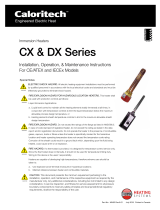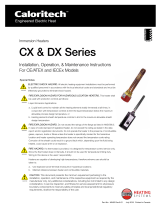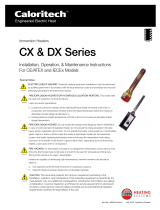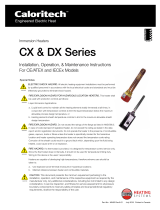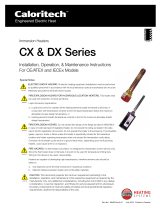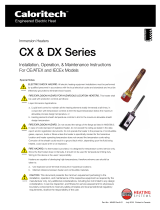Page is loading ...

1
LTFX
Electric Tank
Immersion Heaters
Installation Instructions
PN403-5
161-049178-101
March 2017

2
LTFX
Electric Tank Immersion Heater Installation Instructions
General
The Chromalox Electric Tank Immersion Heater, Model
LTFX, is an engineered, pretested package designed to
give years of virtually maintenance free service and it is
shipped ready for installation into a storage tank. LTFX
provides low watt-density heating over a large heat-
ing surface with precise temperature control for such
materials as asphalt, fuel oil, pitch and tar, liquid sugar,
lube oils, linseed oil, biodiesel, glycerin, ethanol and
many other heat sensitive compounds.
The open coil heating elements (OCE) are housed in
either 2” or 3” Schedule 40 carbon or stainless steel
pipes, which are welded into the 150# ANSI flange.
Once the Unitary Immersion Heater is mated to your
tank, the heating elements may be removed and re-
placed without draining the tank.
Since excessive temperatures may permanently dam-
age the heater and cause premature failure, the use of
temperature controls, limiting controls, and liquid level
sensors are required.
The system designer is responsible for the
safety of this equipment and should install ad-
equate back-up controls and safety devices
with their electric heating equipment. Where
the consequences of failure could result in per-
sonal injury or property damage, back-up con-
trols are essential.
Installation
FIRE OR EXPLOSION HAZARD: The tank must
be purged of all flammable vapors prior to cut-
ting or welding.
High heating efficiency, low element temperatures, and
longer heater life are achieved when the unit is properly
installed.
1. To avoid chipping or cracking, precaution should be
taken while unpacking, handling, and installing the
ceramic insulators. Heaters with damaged insula-
tors should be returned to the factory for repair or
replacement. Contact your local sales office for re-
turn authorization.
2. The LTFX unit must not be mounted in the vertical
position as the resistance wire on the OCE element
can sag, thus causing uneven heating or short cir-
cuit. Unit should be installed in a horizontal position
with the thermowell on top only.
FIRE OR EXPLOSION HAZARD: Mount the heat-
er in a level, horizontal orientation only. All
other orientations may result in property dam-
age or personal injury.
3.
IMPORTANT: Mount heater in the tank so the liquid
level will always be above the effective heated portion
of the heater. Provide expansion tank if necessary.
4. Select a location for this installation according to
the following guidelines: (refer to Figure 1)
A. Heating elements are removable through the ter-
minal enclosure however adequate room must
be provided for this purpose. The removal length
of the OCE heating element is 3 feet since the
center section may be bent on a 12” radius. OCE
elements should only be bent in a vertical plane
with ground strap on the bottom.
B. The neck on the tank’s mating flange should be
of adequate length to accommodate tank insula-
tion and flange bolting.
5. Tube supports (internal to the tank) should be
placed approximately three feet from the ‘wet-side’
of the LTFX flange to ensure gasket sealing integrity.
Additional tube supports can then be spaced on 10
foot centers. Do not anchor the heater tubes to the
supports, as the tubes must be allowed to expand.
6. To ensure proper sealing, a material appropriate
gasket needs to be installed between the mating
flanges. The mating flanges should then be secured
by tightening the bolting according to TEMA Stan-
dards.
7. A tank suction pipe should be mounted at least 2”
above the level of the heaters. A separate line can
be provided to drain tank after heaters have been
de-energized.

3
Allow for Tank
Insulation and Bolting
36” Min. Element
Removal Distance
Model LTFX
Fluid
Level
Open-Coil Elements
Figure 1
Wiring
ELECTRIC SHOCK HAZARD. Disconnect all
power before installing or servicing heater.
Failure to do so could result in personal injury
or property damage. Heater must be installed
or serviced by a qualified person in accordance
with applicable National Electric Codes, NFPA
70 and/or International Electric codes.
ELECTRIC SHOCK HAZARD. Any installation
involving electric heaters must be performed
by a qualified person and must be effectively
grounded in accordance with applicable Na-
tional Electric Codes and/or International Elec-
tric Codes to eliminate shock hazard.
The system designer is responsible for the
safety of this equipment and should install ad-
equate back-up controls and safety devices
with their electric heating equipment. Where
the consequences of failure could result in per-
sonal injury or property damage, back-up con-
trols are essential.
1. Electrical wiring to heating elements must be sized
and installed in accordance with applicable National
Electric Codes, International Electric Codes and/or
and applicable local codes by a qualified person as
defined by the code.
2. Temperatures at the heater terminals will require the
use of manganese nickel or equivalent temperature
lead wire. (Type TGS, TGT, or TGGT are recom-
mended.)
Wiring Entrance Locations - Moisture
Resistant Housing Only (E4 Option)
The Moisture Resistant (E4) Housing offers several
convenient options for conduit wiring & location. The
housing is equipped with two removable service en-
trance plates for installation of wiring. Any or all of the
six sides can be used for wiring locations. Refer to ex-
ploded view drawing. The housing can also be rotated
(by removal from flange) to allow for more position
possibilities. To install service entrance holes, simply
remove the side Allen screws and use the centering
depression to drill the appropriate size hole. Reinstall
the gasket(s), if applicable, and service entrance plates
by tightening the Allen head screws to 4-5 in/lbs. The
‘Octobox’ style of housing can be removed for ease of
access to element bussing or to better locate the pow-
er conduit(s) entry point. To accomplish, simply remove
the Allen-head screws on the outside of the housing.

4
When reinstalling, be sure to properly align gasket, if
applicable, and tighten to 40-50 in/lbs.
Tip for Reinstalling Gaskets:
Place allen head screws through metal covers and
gentle push gasket hole over the threaded screw. This
will allow the gasket to stay in place while tightening
the cover.
Table A – E4 Wiring Information
Heater kW Volts Phase
Total
Amps Circuits
LTFX-125-004E4 4 480 3 4.8 1
LTFX-128-008E4 8 480 3 9.6 1
LTFX-1212-012E4 12 480 3 14.5 1
LTFX-2212-024E4 24 480 3 28.9 1
LTFX-3212-036E4 36 480 3 43.4 1
LTFX-2325-060E4 60 480 3 72.3 1
LTFX-3325-090E4 90 480 3 108.4 3
LTFX-4325-120E4 120 480 3 144.5 2
LTFX-6325-180E4 180 480 3 216.8 3
LTFX-8325-240E4 240 480 3 289.0 4
Wiring Entrance Locations - Explosion
Resistant Housing Only (E2 Option)
The Explosion Resistant (E2) Housing features dedi-
cated conduit connection sizes and locations for either
NPT installation of conduit or Metric cable glands. In-
coming wiring must be suitable for a maximum termi-
nal enclosure temperature of 158˚F (70˚C). Wiring in-
stallation must be in accordance with Hazardous Area
requirements. The use of EYS seals or rigid conduit
may be required. Please consult with the local inspec-
tion authority.
Maximum Temperatures
Safe operation in a hazardous location requires the
maximum operating temperatures of all exposed sur-
faces of the heater including temperatures on the out-
side of the vessel, piping, flanges, screw plugs, enclo-
sures and other heat conducting parts be limited. The
flammable liquids, vapors or gases present determine
the maximum surface temperature permitted in any
hazardous location. The end user or purchaser of the
electric heating equipment is responsible for determin-
ing the proper classification of an area and for provid-
ing Chromalox with hazardous area specifications and
requirements for proper equipment design. (NEC and
IEC provide guidelines for evaluating and classifying
hazardous locations.)
An approved liquid level control or overtemper-
ature control must be installed to deenergize
the heater if the liquid level drops below the
top of the heater.
Maximum fluid temperature per following table:
Temperature Class Maximum Fluid Temperature
T1 (450˚C) 440˚C
T2 (300˚C) 290˚C
T3 (200˚C) 195˚C
T4 (135˚C) 130˚C
T5 (100˚C) 95˚C
T6 (85˚C) 80˚C
The external surfaces of the heater must not exceed
the marked fluid temperature. An over-temperature
control should be used if there is a possibility of the
heater’s external surface temperature exceeding the
fluid temperature.

5
Third Party Certifications
E4 Moisture Resistant Enclosure Certifications
North
American
Designations(s)
Canadian
Designation(s)
European
Designation(s)
International
Designation(s)
Rating NEMA 4 NEMA 4 IP66 IP66
Agency(s)
Manufacturers
Declaration
Manufacturers
Declaration
E2 Explosion Resistant Enclosure Certifications
North American
Designations(s)
Canadian
Designation(s)
European
Designation(s)
International
Designation(s)
Rating Explosion
Resistant
Explosion
Resistant
Explosion
Resistant
Explosion
Resistant
Agency(s) CSAus CSA ATEX IECEx
Ratings Class I, Div. 1
Groups B, C & D
Class I, Div. 1
Groups B, C & D
0359
II 2 G
Ex d IIB+H2 Gb
T1 to T6
Ex d IIB+H2 Gb
T1 to T6
Class II, Div. 1
Groups E, F & G
Class II, Div. 1
Groups E, F & G
IP66 IP66
Class I Zone 1
AEx d
IIB + H2 Gb
T1 to T6
Class I Zone 1
Ex d
IIB + H2 Gb
T1 to T6
-50˚C < Ta < +60˚C
*Note: Temps over T3 (200˚C) require stand-offs for third-party listing. Refer to IECEx and
ATEX certificates for stand-off dimensions.
Table B – E2 Wiring Information
Heater kW Volts Phase
Total
Amps Circuits
LTFX-125-004E2 4 480 3 4.8 1
LTFX-128-008E2 8 480 3 9.6 1
LTFX-1212-012E2 12 480 3 14.5 1
LTFX-3210-024E2 24 480 3 28.9 1
LTFX-3215-036E2 36 480 3 43.4 1
LTFX-3225-060E2 60 480 3 72.3 1
LTFX-4225-090E2 90 480 3 108.4 2
LTFX-8215-120E2 120 480 3 144.5 2
LTFX-9220-180E2 180 480 3 216.8 3
LTFX-12225-240E2 240 480 3 289.0 4
Explosion Resistant Housing Conduit Entry Table
Flange
Size
(In.)
Standard Construction Optional Construction
Conduit/Cable Entries
Per Enclosure
Conduit/Cable Entries
Per Enclosure
3/4” NPT 1-1/2”NPT M20 M40
4 & 5 1 1 1 1
6 1 1 1 1
8 1 2 1 2
10 1 2 1 2
12 1 2 1 2
14 1 3 1 3
16 1 3 1 3
18 1 4 1 4
Note: A minimum of 5 full threads must be engaged on all cable
and conduit entries.

6
FIRE or EXPLOSION HAZARD. Do not open en-
closure when energized. Do not open enclosure
when an explosive gas atmosphere is present.
ELECTRIC SHOCK HAZARD. Disconnect all
power before installing or servicing heater.
Failure to do so could result in personal injury
or property damage. Heater must be installed
or serviced by a qualified person in accordance
with applicable National Electric Codes, NFPA
70, and/or International Electric Codes.
1. Make certain both the terminals and the ceramic
insulators are free from contact with oil, liquid, or
other foreign matter. NOTE: Chromalox cannot be
responsible for failures or damage caused by con-
tamination on the ceramic insulators. Make certain
the heaters are not exposed to contaminants.
2. Check electrical connections at heater terminals
and tighten if necessary. This will help avoid hot ter-
minals which may destroy wire insulation or heater
terminals
3. Check overheat operation to assure heater protection.
Element Replacement - Moisture Resistant Hous-
ing Only (E4 Option)
1. To remove the OCE heating elements, first turn the
circuit breaker to the off position.
2. Next remove the housing lid, element wiring and
the element mounting screw. Now pull the element
straight out of the heating tube. NOTE: OCE ele-
ments should only be bent in a vertical plane with
ground strap on the bottom.
3.
When removing the heating elements, make certain that
the terminals and the ceramic insulators do not contact
oil or any other liquid foreign matter. Note: Chromalox
cannot be responsible for failures or damage caused
by contamination on the ceramic insulators.
4. Installation is the reverse of the above.
Element Replacement - Hazardous Locations,
Explosion Resistant Housing Only (E2 option)
1. To remove the OCE heating assembly, first turn the
circuit breaker to the off position.
2.
Next remove the housing lid, element wiring, and 8mm
bolting around the element flamepath module. If bolts
must be replaced, use a minimum of grade 10.9. If
needed, (2) M6-1.0 bolts may be used to break loose
the module from the flange. Turn bolts evenly until
module is free. The flamepath module will be re-used,
so disconnect the heating element from the module
pins. Now pull the element assembly out of the heat-
ing tube. NOTE: OCE elements should only be bent
in a vertical plane with ground strap on the bottom.
3.
When removing the heating elements, make certain that
the terminals and the ceramic insulators do not contact
oil or any other liquid foreign matter. Note: Chromalox
cannot be responsible for failures or damage caused
by contamination on the ceramic insulators.
Operation
FIRE OR EXPLOSION HAZARD. To avoid possi-
ble damage to the heater, do not energize until
the tank is filled with fluid. Recommended fluid
level is 2” above the heater tube or pipe.
FIRE or EXPLOSION HAZARD. Do not open en-
closure when energized. Do not open enclosure
when an explosive gas atmosphere is present.
1. Do not operate heaters at voltages in excess of that
stamped on the heater, since excess voltage will
shorten heater life.
2. Heaters should not be operated in environments
with factors that can destroy the electrical insulating
characteristics of the ceramic insulators. Foreign
contaminants can create leakage (shock) hazards,
permanent heater damage, or cause heater failure
and therefore should be avoided.
For initial operation and tuning the control scheme:
1. Turn the master circuit breaker off and open the
control box door.
2. Set the indicating temperature control at the de-
sired temperature and the over-temperature cutout
at 50°F above this temperature.
3. Interlock the liquid level control with the cutout de-
vice.
4. Close the control box door and turn the circuit
breaker on. To energize the heater circuits, turn the
on-off selector switch to the “on” position.
Maintenance

7
Renewal Parts Identification
Table C – E4 Housing Renewal Parts Identification
Heater Model kW Volts Phase
Immersion
Length In.
(mm)
ANSI
Flange Size
Number
of Tubes
Nominal
Tube Dia.
(In)
Replacement OCE
Model No.
LTFX-125-004E4 4 480 3 60 (1,524)
4" - 150# 1 2”
OCE-05040-2-483
LTFX-128-008E4 8 480 3 96 (2,438)
4" - 150# 1 2”
OCE-06080-2-483
LTFX-1212-012E4 12 480 3 144 (3,658)
4" - 150# 1 2”
OCE-12120-2-483
LTFX-2212-024E4 24 480 3 144 (3,658)
6" - 150# 2 2”
OCE-12120-2-483
LTFX-3212-036E4 36 480 3 144 (3,658)
6" - 150# 3 2”
OCE-12120-2-483
LTFX-2325-060E4 60 480 3 300 (7,620)
8" - 150# 2 3”
OCE-25300-3-483
LTFX-3325-090E4 90 480 3 300 (7,620)
10" - 150# 3 3”
OCE-25300-3-483
LTFX-4325-120E4 120 480 3 300 (7,620)
10" - 150# 4 3”
OCE-25300-3-483
LTFX-6325-180E4 180 480 3 300 (7,620)
12" - 150# 6 3”
OCE-25300-3-483
LTFX-8325-240E4 240 480 3 300 (7,620)
14" - 150# 8 3”
OCE-25300-3-483
Table D – E2 Housing Renewal Parts Identification
Heater Model kW Volts Phase
Immersion
Length In.
(mm)
ANSI
Flange Size
Number
of Tubes
Nominal
Tube Dia.
(In)
Replacement OCE
Model No.
LTFX-125-004E2 4 480 3 66 (1,676)
4" - 150# 1 2”
OCE-06040-2-483
LTFX-128-008E2 8 480 3 96 (2,438)
4" - 150# 1 2”
OCE-06080-2-483
LTFX-1212-012E2 12 480 3 144 (3,658)
4" - 150# 1 2”
OCE-06080-2-483
LTFX-3210-024E2 24 480 3 120 (3,048)
8" - 150# 3 2”
OCE-06080-2-483
LTFX-3215-036E2 36 480 3 180 (4,572)
8" - 150# 3 2”
OCE-06080-2-483
LTFX-3225-060E2 60 480 3 300 (7,620)
8" - 150# 3 2”
OCE-25200-2-4803
LTFX-4225-090E2 90 480 3 300 (7,620)
10" - 150# 4 2”
OCE-25225-2-4803
LTFX-8215-120E2 120 480 3 180 (4,572)
12" - 150# 8 2”
OCE-15150-2-4803
LTFX-9220-180E2 180 480 3 240 (6,096)
14" - 150# 9 2”
OCE-25200-2-4803
LTFX-12225-240E2 240 480 3 300 (7,620)
14" - 150# 12 2”
OCE-25200-2-4803
4. Inspect the element assembly flange and mat-
ing surface for any debris, oils, or contamination.
NOTE: Surfaces must be in suitable condition to en-
sure proper hazardous rating.
5. Wire connection to OCE heating element should
be made using ring connectors. Wire connection to
flamepath module must be made with crimp-style
barrel connectors. If wires between flamepath mod-
ule and OCE element need to be replaced, the wires
should be rated for a minimum of 250˚C. It is also
required to cover the barrel connector, wire and ring
connector with electrical sleeving to prevent un-
wanted grounding. Connect the new element to the
flame path module by wiring connection(s) to the
OCE element and slide the OCE element into tube.
6. Connect the new element to the flamepath module
and slide into tube. Flamepath module bolting must
be tightened to 26 ft/lbs. of torque.
7. Reattach element wiring. When reinstalling hous-
ing lid, be sure to properly align gasket, and tighten
housing bolts to 26 ft/lbs.

8
© 2017 Chromalox, Inc.
Limited Warranty:
Please refer to the Chromalox limited warranty applicable to this product at
http://www.chromalox.com/customer-service/policies/termsofsale.aspx.
Chromalox, Inc.
1347 Heil Quaker Boulevard
Lavergne, TN 37086
(615) 793-3900
www.chromalox.com
/
